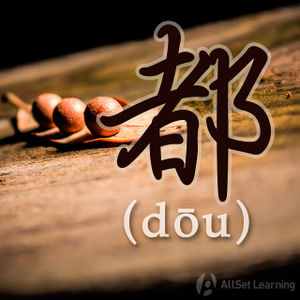Difference between revisions of "Indicating the whole with "quan""
| Line 95: | Line 95: | ||
<div class="liju"> | <div class="liju"> | ||
| − | * | + | *中国 菜 我 不 是 <em>全</em> <em>都</em> 喜欢 。 <span class="pinyin">Zhōngguó cài wǒ bù shì <em>quán</em> <em>dōu</em> xǐhuan.</span><span class="trans">I don't like all Chinese food.</span> |
| + | *这 篇 文章 太 长 了 ,我 没 <em>全</em> <em>都</em> 看完 。<span class="pinyin">Zhè piān wénzhāng tài cháng le, wǒ méi <em> quán</em> <em> dōu</em> kàn wán.</span><span class="trans">This article is too long. I didn't finish reading it all.</span> | ||
*他 的 话 你 不 能 <em>全</em> <em>都</em> 相信 。 <span class="pinyin">Tā de huà nǐ bù néng <em> quán</em> <em> dōu</em> xiāngxìn.</span><span class="trans">You can't believe everything he says.</span> | *他 的 话 你 不 能 <em>全</em> <em>都</em> 相信 。 <span class="pinyin">Tā de huà nǐ bù néng <em> quán</em> <em> dōu</em> xiāngxìn.</span><span class="trans">You can't believe everything he says.</span> | ||
| − | * | + | *你 说 得 太 快 了 ,我 不 可能 <em>全</em> <em>都</em> 记 下来 。 <span class="trans">You spoke too fast. I can't write down all of what you said.</span> |
| − | + | *地方 太 小 ,我们 的 朋友 不 能 <em>全</em> <em>都</em> 邀请 来 。 <span class="pinyin">Dìfang tài xiǎo, wǒmen de péngyou bù néng <em>quán</em> <em>dōu</em> yāoqǐng lái.</span><span class="trans">The place is too small. We can't invite all our friends to come.</span> | |
| − | * | ||
</div> | </div> | ||
Revision as of 03:58, 21 August 2017
| This article is a stub. Editors can help the Chinese Grammar Wiki by expanding it. |
-
Level
-
Similar to
-
Used for
-
Keywords
One of the uses of 全 (quán) is to indicate the entirety of something. It could be used for something like a whole household, an entire country, the whole world, etc.
Using 全 before a Noun
Structure
The structure is quite simple, just put 全 in front of the noun you want to emphasize "the whole" of. You cannot use it with 的. Pay attention to the types of nouns you can use with 全, since it is usually paired up with 身 (body), 家 (family), 国 (country), 世界 (world), 天 (day) and the like.
全 + Noun + 都 + Verb
Examples
- 我们 全 家 都 去 过 北京 。Our entire family have been to Beijing.
- 全 国 人民 都 知道 这个 新闻 。People in the whole country know about this news.
- 全 公司 的 人 都 不 喜欢 新 老板 。The whole company doesn't like the new boss.
- 打 完 球 以后 我 全 身 都 是 汗 。My whole body sweat after playing the ball.
- 全 校 的 学生 都 放假 了 。 Students in the whole school are on holiday.
- 你 明天 全 天 都 在 吗 ?Are you going to be here the whole day tomorrow?
- 这个 地方 全 年 都 很 热 。It's hot here the whole year.
Using 全都 before a Verb
Affirmative Pattern
Before a verb 全 can be omitted, but if it is used, the purpose is to emphasize the idea of "all" or "entire."
Structure
Subj. + 全 + 都 + Verb / Adj.
Examples
- 大家 全 都 到 了。Everybody has come.
- 作业 全 都 做 完 了 吗?You've finished all your homework?
- 我 全 都 听懂 了。I heard and understood all.
- 你 全 都 拿 走 吧。Take them all.
- 他 把 咖啡 全 都 喝 了。He drank up all the coffee.
Negative Pattern: Total Negation
Structure
When you negate 全都 with 不 or 没 after it, you're not just saying "not entirely," you're saying "none of it" or "not at all."
Subj. + 全都 + 不 / 没 + Verb / Adj.
Examples
- 他们 全 都 没 去。None of them went.
- 这 个 周末 我们 全 都 不 在 家。None of us will be home this weekend.
- 他 说 的 话 全 都 不 要 相信。Don't believe anything he says.
- 你们 的 员工 全 都 不 会 说 英语 吗?None of your employees can speak English?
- 你 的 家人 全 都 没 来 参加 你 的 婚礼 ? None of your family came to your wedding?
Negative Pattern: Partial Negation
Structure
When you negate by putting 不 or 没 before 全都, you're only partially negating. In other words, you're communicating "not all."
Subj.+不 / 没+全都+Verb / Adj.
Examples
- 中国 菜 我 不 是 全 都 喜欢 。 I don't like all Chinese food.
- 这 篇 文章 太 长 了 ,我 没 全 都 看完 。This article is too long. I didn't finish reading it all.
- 他 的 话 你 不 能 全 都 相信 。 You can't believe everything he says.
- 你 说 得 太 快 了 ,我 不 可能 全 都 记 下来 。 You spoke too fast. I can't write down all of what you said.
- 地方 太 小 ,我们 的 朋友 不 能 全 都 邀请 来 。 The place is too small. We can't invite all our friends to come.
See also
- Referring to "all" using "suoyou"
- Expressing "Everyone" with "shei"
- Expressing "All" with "shenme dou"
- Expressing "Every" with "mei" and "dou"
- Emphasizing quantity with "dou"



